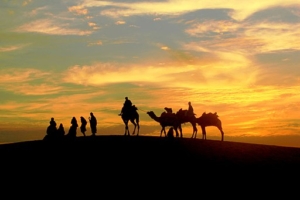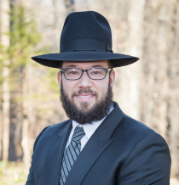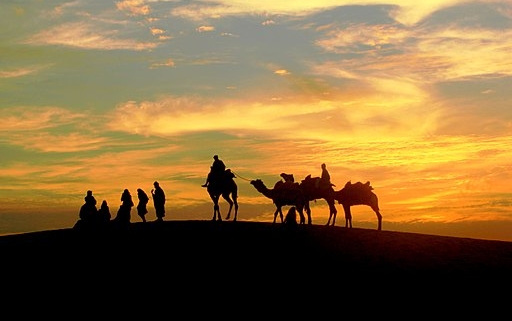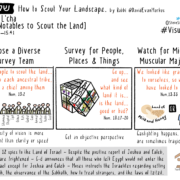Bamidbar: The Wander Years and Traveling Together
Introduction to Sefer Bamidbar: The Wander Years
by Rabbi Dara Lithwick
The fourth book of Moses, Bamidbar (“in the desert”), begins where the book of Exodus left off: with the Israelites in the desert after they finished building the Mishkan and Tabernacle. Bamidbar occupies a unique role in the biblical canon. While Bereishit (Genesis) is a book of creation and beginnings of the Abrahamic line, Shemot (Exodus) is the story of the Exodus and origins of the Israelites as a people, and Vayikra (Leviticus) details rules of holiness and priestly elements, Bamidbar contains the crux of the Israelites’ story that takes place literally bamidbar, in the desert. In this liminal space, neither home nor destination, inhospitable and challenging, the Israelites struggle through their collective adolescence of becoming a community, a people.
In these “wander” years of Bamidbar, the Israelites (males) are counted (twice), they learn about the harsh rules of the sotah (which dances with how to manage jealousy and intimacy and mutual respect in relationships) and the strict vows of the nazir (is asceticism a thing?). On a snazzier note, God directs Aaron and his sons in giving the priestly blessing to the Israelites. And throughout the book of Bamidbar there is a lot of kvetching – about manna, about schlepping, about leadership and more. There is a full on rebellion (with Korach), and disastrous consequences. There are sibling issues involving leshon hara (bad speech) and punishment (of Miriam) and prayer for healing (by Moshe for Miriam). Women, the daughters of Zelophehad, speak out against gender inequality, and some (minor) improvements are made when God listens. There are issues with Moab and Amalek and consequences there too. As the Israelites approach the land of Israel, there are disputes regarding where tribes are to settle (Reuben and Gad eye some grassy land great for cattle just outside Israel and want to stay there) and how to ensure that they don’t abandon their fellow tribes in Israel proper. There are conflicts and some resolution.
As science fiction author Ursula K. LeGuin wrote “it is good to have an end to journey towards, but it is the journey that matters, in the end.” Through the struggle of the Israelites’ wander years in Bamidbar, they forge an ethos, an identity, that they did not have before. Reality is messy as people have diverse needs, capacities, wants, and hopes. It is one thing to have laws like the commandments and mishpatim set out in Shemot/Exodus. It is quite another to live them in practice. Looking at the book through an ethic of social justice, of tikkum olam, Bamidbar recognizes the importance of taking into account the learning and growth that must take place to fulfill a vision of a redeemed world. Also, Bamidbar begins and ends with a census. Rashi and other sages teach that God counted the Israelites with love, honouring each individual’s essence. In our social justice work may we do so too.
Below, Rabbi Mike Moskowitz takes a deeper dive into one verse from this week’s parsha, Bamidbar, that further emphasizes the value and role of individuals building community – of how when we work together our whole is greater than the sum of our parts, and that through our care for each other we draw closer to, and I would add show our love for, the Divine.

Image source: File:Suneset in Desert.jpg – Wikimedia Commons
D’var Torah for Parsha Bamidbar: Traveling Together
by Rabbi Mike Moskowitz
וְעָלָ֖יו מַטֵּ֣ה מְנַשֶּׁ֑ה וְנָשִׂיא֙ לִבְנֵ֣י מְנַשֶּׁ֔ה גַּמְלִיאֵ֖ל בֶּן־פְּדָהצֽוּר׃
And next to him [Ephraim] are the tribe of Manasseh – and the prince of the children of Manasseh is Gamaliel son of Pedahzur.
Numbers 2:20
Closeness isn’t always determined by geographical distance. Often, surprisingly, physical separation between people can generate a yearning that builds connectivity from afar. Joseph’s longing to be reunited with his father, Jacob, produced an attachment that was so powerful it bridged a generational gap causing his father to acknowledge Joseph’s sons as his own:1 “Now, your two sons, who were born to you in the land of Egypt before I came to you in Egypt, shall be mine; Ephraim and Manasseh shall be mine no less than Reuben and Simeon.”2
Even the name of the esoteric figure mentioned here, Gamaliel the son of Pedahzur, the leader of the tribe of Manasseh, is a declaration of his ancestral gratitude for personalized attention. Our sages interpret his first name, גמליאל, as “G-d did kindness for me.” They also see an allusion in his father’s name ,פדהצור meaning “G-d liberated me from imprisonment.”
Ephraim and Manasseh were not only loved as sons by both Jacob and Joseph, but they shared a special bond between them. This connection is echoed in the unique description of the encampments. When the verse chronicles the placement of the other tribes it is expressed as “וְהַחוֹנִ֥ם עָלָ֖יו – encamped next to.” “וְהַחוֹנִ֥ם – encamped” while implied by the context, is oddly omitted by Joseph’s sons. Although the other tribes were in fact brothers, they created borders that were more suitable for neighbors, not family.3
While “encamped” suggests something stationary, the preposition “עָלָ֖יו” includes a language of elevation. Though normally understood as “by him” it is linguistically related to “his ascent,” which hints at Ephraim and Manasseh’s availability for movement, not limited to a fixed occupation of space. Joseph, which means “to increase,” was named by his mother Rachel with the intention of expanding possibilities.4 It is this lineal aspiration for change and growth that transcends boundaries and allows for a coming together that unites over division.5
Harmonious coexistence between people is so powerful because it reflects G-d’s oneness. The way that we treat people informs that way that G-d relates to us. If we are forgiving of those who have wronged us, then G-d, we are told, is more inclined to be forgiving. When we focus on the needs of another, G-d reciprocates and focuses on our needs.6 This is true to such an extreme extent that the Talmud,7 quoting from the prophet Hosea,8 posits that a breakdown in communal cohesion, through baseless hatred, is worse than idolatry – as it is written: “חֲב֧וּר עֲצַבִּ֛ים אֶפְרָ֖יִם הַֽנַּֽח־לֽוֹ – Ephraim is attached to idols, but let him be.” The Talmud continues and explains “בזמן שהם מתחברין ואפי’ לעצביהם הנח להם – As long as they are joined together, even [to worship] their idols, let them be.”
Sometimes this cohesion is [indeed] expressed as a physical nearness. Abaye teaches that a person should attach themselves to the congregation at all times, always praying for peace in the plural on behalf of the collective.9 The Rabbis understand that a community isn’t an association of people, the sum total of individuals coming together for a shared interest, but an entirely new entity.10
The strength of a collective is not determined by the quantity of its members, but by the quality of their bond. The Midrash11 contrasts the different nature[s] of physical and spiritual support: “It is the practice of the world that what is heavy for one person to carry, is made comfortable by another’s assistance.” The Midrash continues “If something is difficult for two people to carry, four people can manage it with ease. However, when it came to accepting the Torah at Mount Sinai, what was a difficult burden for six hundred thousand was an easy lift for one person.”
No single person has 613 commandments, because the Torah was never given to an individual, but rather to a nation. A group of people coming together for a purpose is not the same as coming together as one person, as our rabbis12 describe the Children of Israel “like one person with one heart”.
Just as a shared cup of sugar between neighbors builds a community well beyond the provision of a simple ingredient, so contributing to the wellbeing of others creates a connection extending above the physical resources of those in need of them. “So great is providing for others (לגימה) that it is – מקרבת את הרחוקים – bringing close those who are distant.”13
Parshas Bamidbar is always read just before the festival of Shavuot, where we reencounter the Divine in acceptance of the Torah. It is intended to remind us that through our care for each other, we advance our closeness to the Divine.
Endnotes
- Toras Moshe Nasson page 37.
- Genesis 48:5.
- See Moshav Zekenim.
- Genesis 30:25.
- See Avrah D’Dasha.
- Arvei Nachal Mekietz.
- Tractate Kallah Rabbasi 8:8.
- 4:17.
- Berachos 30a.
- See Drashos HaRan.
- Vayikra Rabbah.
- Mekhilta d’Rabbi Yishmael 19:2.
- Sanhedrin 103b.

Rabbi Dara Lithwick, the lead builder at Builders Blog, is an advocate for LGBTQ2+ inclusion. When not at work as a constitutional and parliamentary affairs lawyer, Rabbi Dara chairs the Reform Jewish Community of Canada’s Tikkun Olam Steering Committee and is active at Temple Israel Ottawa, and in the winter serves as ski patrol at Sommet Edelweiss. She is a member of Bayit’s Board of Directors.

Rabbi Mike Moskowitz, a founding builder at Bayit and also a member of Bayit’s Board, serves as Scholar-in-Residence for Queer and Trans Jewish Studies at Congregation Beit Simchat Torah, a flagship LGBTQIA+ synagogue in New York City.









